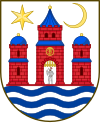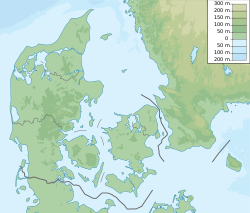Copenhague
|
Copenhagen København |
||
|---|---|---|

|
||
|
||
| Coordinates: 55°40′34″N 12°34′06″E / 55.67611°N 12.56833°ECoordinates: 55°40′34″N 12°34′06″E / 55.67611°N 12.56833°E | ||
| Country | Denmark | |
| Region | Capital (Hovedstaden) | |
| First mention | 11th century | |
| City Status | 13th century | |
| Area | ||
| • Municipal | 86.39 km2 (33.36 sq mi) | |
| Highest elevation | 91 m (299 ft) | |
| Lowest elevation | 1 m (3 ft) | |
| Population (January 2017) | ||
| • Municipal | 1,295,686 (details) | |
| • Urban | 1,295,686 (details) | |
| • Metro | 2,036,717 (details) | |
| • Ethnicity | 76.14% Danes 23.86% Other |
|
| Demonym(s) | ||
| Time zone | CET (UTC+1) | |
| • Summer (DST) | CEST (UTC+2) | |
| Postal code | 1050–1778, 2100, 2150, 2200, 2300, 2400, 2450, 2500 | |
| Area code(s) | (+45) 3 | |
| GDP(nominal) Capital Region of Denmark | 2015 | |
| - Total | $105 billion | |
| - Per capita | $60,000 | |
| Website | www |
|
|
|
| First-generation immigrants by country of origin (Q12016) |
|
|---|---|
| Nationality | Population |
|
|
5,409 |
|
|
5,197 |
|
|
4,767 |
|
|
4,560 |
|
|
4,407 |
|
|
4,168 |
|
|
4,471 |
|
|
3,836 |
|
|
3,292 |
|
|
3,244 |
|
|
3,098 |
|
|
3,002 |
Copenhagen (Danish: København [kʰøb̥m̩ˈhɑʊ̯ˀn]; Latin: Hafnia) is the capital and most populous city of Denmark. The city has a population of 763,908 (as of December 2016[update]), of whom 601,448 live in the Municipality of Copenhagen. The larger urban area has a population of 1,280,371 (as of 1 January 2016[update]), while the Copenhagen metropolitan area has just over 2 million inhabitants. Copenhagen is situated on the eastern coast of the island of Zealand; another small portion of the city is located on Amager, and is separated from Malmö, Sweden, by the strait of Øresund. The Øresund Bridge connects the two cities by rail and road.
Originally a Viking fishing village founded in the 10th century, Copenhagen became the capital of Denmark in the early 15th century. Beginning in the 17th century it consolidated its position as a regional centre of power with its institutions, defences and armed forces. After suffering from the effects of plague and fire in the 18th century, the city underwent a period of redevelopment. This included construction of the prestigious district of Frederiksstaden and founding of such cultural institutions as the Royal Theatre and the Royal Academy of Fine Arts. After further disasters in the early 19th century when Nelson attacked the Dano-Norwegian fleet and bombarded the city, rebuilding during the Danish Golden Age brought a Neoclassical look to Copenhagen's architecture. Later, following the Second World War, the Finger Plan fostered the development of housing and businesses along the five urban railway routes stretching out from the city centre.
...
Wikipedia


